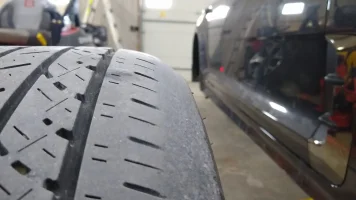Stinger-Performance
Member
My Stinger has about 27k miles on it. While rotating the tires today I noticed the rear is eating the inside edge very bad. After the car was back down on the ground, I can visibly tell the camber is off. I've not yet rigged up a way to measure camber at home but I will soon.
When searching I find people talking about rear camber adjustment on lowered cars (which makes sense) but has anyone had issues with a stock ride height/stock springs Stinger having rear camber issues? I could understand it if it if the car was 10 years old and had a bunch of mileage with sagging springs but 27k miles is nothing for suspension components. I've attached three pics showing the inside, outside, and whole width of the tire.

When searching I find people talking about rear camber adjustment on lowered cars (which makes sense) but has anyone had issues with a stock ride height/stock springs Stinger having rear camber issues? I could understand it if it if the car was 10 years old and had a bunch of mileage with sagging springs but 27k miles is nothing for suspension components. I've attached three pics showing the inside, outside, and whole width of the tire.







